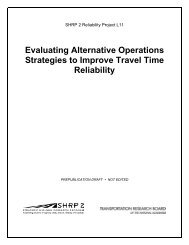Contemporary Approaches to Parking Pricing: - FHWA Operations
Contemporary Approaches to Parking Pricing: - FHWA Operations
Contemporary Approaches to Parking Pricing: - FHWA Operations
Create successful ePaper yourself
Turn your PDF publications into a flip-book with our unique Google optimized e-Paper software.
will be available <strong>to</strong> offer assistance <strong>to</strong> parkers. Pay-in-lane systems cost less than pay on foot because they do not require<br />
both pay stations and exit verifiers. Exit flow can be significantly reduced with pay in lane compared <strong>to</strong> pay on<br />
foot. Pay in lane can provide a way <strong>to</strong> reduce staffing needs during less busy times when parking demand, and therefore<br />
exiting traffic flow, is low (e.g., during evening hours or on weekends).<br />
License Plate Recognition Technology<br />
LPR technology uses cameras and optical character recognition <strong>to</strong> read license plates. The systems can be hand-held<br />
or vehicle-mounted and work in daylight and low-light conditions. Once read, the license plate is referenced against<br />
a database containing violation, payment, and other pertinent information.<br />
LPR also serves as an enforcement and data collection mechanism. It is able <strong>to</strong> determine if a vehicle has remained<br />
in a parking space or district beyond allowed time limits or lacks a necessary parking permit. The technology can<br />
also be integrated with payment systems for off-street parking facilities. Entrance and exit barriers will au<strong>to</strong>matically<br />
open for registered vehicles. If appropriate, users’ accounts can be charged for the amount of time spent in the<br />
facility. LPR is also able <strong>to</strong> moni<strong>to</strong>r vehicle occupancy and duration in both on-street and off-street facilities.<br />
The systems help prevent fraud by replacing printed permits, can significantly decrease staffing requirements for<br />
enforcement personnel, can identify s<strong>to</strong>len or wanted vehicles, and can simplify duration counts. LPR technology<br />
is not perfect, however. Systems may have trouble reading some States’ license plates, worn out license plates generally<br />
cannot be read, the readers are not effective if license plates are covered with debris such as dirt or snow, errors<br />
occur if enforcement personnel with vehicle-mounted systems drive <strong>to</strong>o fast, and community members may raise<br />
privacy concerns.<br />
<strong>Parking</strong> Space Sensors<br />
<strong>Parking</strong> space sensors typically use ultrasonic, magne<strong>to</strong>meter, or digital-camera<br />
technology <strong>to</strong> determine if a space is occupied. The sensors can be placed in pavement,<br />
affixed <strong>to</strong> single-space parking meters, or hung from ceilings in parking<br />
garages. Space sensors are used for enforcement, data collection, and informing<br />
users of the location of available spaces. Data can also be used <strong>to</strong> determine occupancy<br />
rates.<br />
Data from space sensors can be posted on Web sites, accessed through smart<br />
phones, or provided on message signs so that drivers know where <strong>to</strong> find open<br />
parking spaces. In off-street facilities the increased reliability associated with sensor<br />
data (versus magnetic loops) allows occupancy <strong>to</strong> be increased from an industry<br />
standard of 85 percent <strong>to</strong> 90 <strong>to</strong> 92 percent. Newer digital-camera parking<br />
sensors are able <strong>to</strong> determine vehicle type, color, and license plate number. If<br />
people cannot find their car they can enter basic details about their vehicle and<br />
the system will tell them where their vehicle is parked.<br />
There are some drawbacks <strong>to</strong> these systems. The current cost of space sensors keeps them beyond the financial<br />
reach of most cities and parking facility opera<strong>to</strong>rs. In-pavement sensors can allow water <strong>to</strong> flow behind them, negatively<br />
impacting the life of paving materials. Some sensors must also be flush mounted for snow removal and require<br />
battery replacement approximately every 5 years. Privacy concerns may also be raised with the use of camera sensors<br />
that record license plate information.<br />
Pho<strong>to</strong> credit: SFpark<br />
C o n t e m p o r a r y A p p r o a c h e s t o P a r k i n g P r i c i n g | 11















